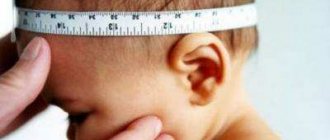Here he is lying in his crib, still just a baby, but so interesting. How will this baby grow up? It turns out that there are formulas with which you can calculate the future growth of a child.
Source: instagram @valiobaby
It is difficult to say how accurate these formulas are, especially considering that a child’s growth is influenced by many factors - nutrition, health, and physical activity. Even whose genes turn out to be dominant - mother’s or father’s, or perhaps those that were passed on in transit from grandparents.
Standards for height and weight of a child from 0 to 10 years: WHO tables in the form of a calculator
You probably shouldn’t take this calculation particularly seriously, however, for many the values are the same - you can try to calculate your height or your husband’s height by comparing the heights of your parents. But here it is worth considering that in older people the length of the bones decreases and the value may differ from what it was in youth. So, the formulas for calculating the future growth of a child:
Child growth chart: growth standards for boys and girls from birth to 18 years
Probably all parents have noticed that each child develops differently; even in the same family, children can be of different heights and different fatness. Currently, growth rates at a given age are most reliable in the WHO table. However, many pediatricians use the data provided in tables developed by the Russian Ministry of Health.
Height and weight chart for children and teenagers
The table data is compiled based on the average data of peers. Children with very short or tall stature compared to the table data should be referred for examination to an endocrinologist. He, in turn, must establish the reasons for such development of the child. And if necessary, prescribe treatment.
How to measure a child's height?
Child's height . Can it be predicted? What affects a child's growth?
A child's growth is one of the main indicators of his physical development. Parents must remember that growth must be measured not only at birth and during the first years of life, but also every subsequent year (at least once a year) in order to assess its dynamics. To do this, it is convenient to use special height meters or make notes on the wall the old fashioned way, and after a few years remember with tenderness how small your little one once was. The growth of a child is based on two physiological processes: an increase in the size of adipose tissue, muscle mass, skeletal bones, as well as biochemical and endocrine changes. As you grow, the amount of cartilage tissue in the skeleton decreases, giving way to bone. The growth process can be considered complete when the cartilage tissue is completely replaced by bone. As a rule, this happens by the age of 20-25. And if you take care of growth issues a little earlier, you can help your baby grow a little. Growth is best adjusted between 8 and 13 years of age. If you want to “lengthen” your child a little, it is important to know what factors influence growth.
Usually girls begin to actively grow at the age of 9-10 years. In this case, the peak growth rate occurs at 11-12 years, which coincides with intensive sexual development. In boys, active growth begins a little later (about 11 years) and reaches its maximum by 13 years. This is why in high school girls are taller than boys at first, and then this changes.
During a growth spurt, guys normally manage to grow by 9-10 cm per year, and girls - by 7-8 cm per year. This explains the fact that men are usually 10-12 cm taller than women. The growth rate slows down towards the end of puberty. This is due to the fact that the growth of cartilage, which is located at the ends of long tubular bones, practically stops.
Growth factors
Growth is influenced by many internal and external factors:
- heredity - not only the height of parents, but also the peculiarities of the formation of their body in childhood and adolescence;
- age of onset of sexual development (puberty);
- nature of nutrition;
- the presence of any chronic diseases;
- physical activity;
- use of certain medications.
- Bad habits during puberty - smoking, alcohol, drugs
Let's take a closer look at the nature of nutrition first.
The growth of a child depends on the provision of the body with the full complex of nutrients necessary for development: proteins, fats, carbohydrates, minerals, vitamins. This means that the child’s diet must include meat, fish, cheese, dairy products, and cereals. It should be noted that growth is inhibited not only in severe forms of protein deficiency, but also in asymptomatic deficiency of nutrients and minerals and individual vitamins. For example, vitamin D, calcium. The upward trend in adult height that has emerged over the last century appears to be related to improved diets, especially the increased proportion of protein in young children's diets. What food components mainly affect a child’s growth? Proteins are the main building material of our body. Contained in almost all organs and tissues. Proteins of animal origin (contained in meat, fish, etc.) are more complete (in terms of the composition of essential amino acids) and more digestible. Calcium is necessary for normal growth of bones and teeth. The largest amount is found in milk and dairy products. The daily requirement of calcium for children is higher than for adults and is 1200 mg per day. Vitamin D promotes the absorption of calcium and phosphorus, the growth and development of bones and teeth. It is found in milk and butter, egg yolk, fatty fish, and is produced in the skin in sunlight. Vitamin A (retinol - in animal products, beta-carotene - in plant products) is necessary for body growth and normal development of cells of the mucous membranes and skin. The main sources of retinol are animal liver, salmon fish, egg yolk, and dairy products; beta-carotene – orange, yellow-red and dark green vegetables and fruits: carrots, tomatoes, pumpkin, herbs, apricots, peaches.
A healthy lifestyle is a guarantee of good growth!
A healthy, nutritious diet, regular exercise, and good, adequate sleep help achieve maximum growth. Most children do not need to take any additional nutritional supplements because all essential nutrients are obtained from food.
You should be wary of any products that promise to make you taller. In some pharmacies you can find tablets whose labels say “growth stimulant” or “growth hormone”, but growth hormone is a medicine that should not be taken without a doctor’s prescription.
Sometimes a doctor may prescribe such a drug, but only for strict medical reasons, such as proven severe growth hormone deficiency. HGH has certain side effects: it can cause diabetes and fluid buildup in the brain (hydrocephalus).
Speaking of sports. All physical activity must be strictly dosed and appropriate to the age of your child. Don't overdo it. Everything is good in moderation, otherwise you will get the opposite effect.
Jumping and sports games with them (volleyball, basketball, tennis, baseball) stimulate growth. But sports such as skiing, cycling, judo are not recommended for short people, because first of all they develop muscles to the detriment of bone tissue.
Breathe fully! Another significant factor is the supply of oxygen to the body. Therefore, it is necessary to ensure that the baby breathes correctly. Even an ordinary, prolonged runny nose deserves the close attention of parents.
Speaking of hormones.
The growth of a child largely depends on the production of certain hormones in the body, the decrease of which can lead to growth retardation. A significant role in matters of growth is given to somatotropic hormone (growth hormone). From birth until puberty, it plays a key role in regulating growth. This hormone is produced in the pituitary gland, an endocrine gland located in the brain. Most of this hormone is secreted during sleep, so the more sleep a child gets at night, the better he grows. Growth hormone deficiency develops in various diseases of the pituitary gland and is treated with genetically engineered growth hormone drugs. The absence of thyroid hormones is accompanied by an almost complete cessation of growth. Thus, normal levels of these hormones are essential for proper growth. Thyroid hormone deficiency develops when the function of the thyroid gland decreases and leads to a decrease in the secretion of growth hormone. In addition to a decrease in growth rates, it is manifested by increased fatigue, decreased concentration and attention of the child, dry skin, etc. To prevent thyroid diseases, residents of iodine-deficient areas (Moscow is no exception) should eat iodized salt, as well as seafood and seaweed. Androgens (male sex hormones) and estrogens (female sex hormones) stimulate growth during puberty. They are the main reason for the pubertal growth acceleration. Androgens directly stimulate the growth and maturation of bones, cartilage and muscles. Estrogens in low concentrations accelerate growth, and in high concentrations, on the contrary, they slow down. In addition, estrogens are responsible for the closure of growth plates and cessation of growth. Basic patterns of child growth It is known that growth is controlled by more than a hundred genes, which finally realize their influence by the age of 18, so it is impossible to predict the final height of a child. However, to calculate the average height of children under 10 years of age, the following pattern can be used: infants in the first year of life grow fastest; at birth, their average height is about 50 cm; during the first year of life, it increases by an average of 25 cm; the second - by 12.5 and then annually by 4-6 cm. The main “jump” in growth is observed in children during puberty (12-14 years). In girls, it begins a little earlier - at 11-12 years old and is accompanied by a moderate acceleration of growth (8-9 cm per year). In boys, puberty begins later - at 12-14 years old, but is accompanied by a greater acceleration of growth - up to 9.5-11 cm per year.
French pediatrician Belay even compiled a table with which you can find out your child's future growth.
You can take your child to see an endocrinologist. You will be sent for pictures of your fingers. From the image, the doctor will see “growth points”, from which he can predict growth in the future. This is certainly important when a child is involved in any kind of sport and shows great promise, so sometimes it is necessary to know whether the child should continue to move in the direction of a “big” sport or change the direction and loads in time. If you want to slightly influence the baby’s growth, you can do special “lengthening gymnastics.”
A set of exercises.
1. Immediately after waking up, stretch your arms up, high, high, towards the sun itself! 2. Now stand up with your back straight. Take your right leg to the side and raise your left arm up. Now stretch properly. Do the same with your left leg and right hand. 3. A similar exercise can be performed while lying on your back: you need to stretch your left arm and right leg diagonally, and then vice versa – your left leg and right arm. 4. Now get on all fours, take your straight leg as high as possible and pull it up. First one, then the second. 5. It's time to wash your face! And the best way to get to the bathroom is to tiptoe, with your hands up. This exercise is very useful for the development of bone tissue. I would also like to note that you should not be overly focused on your child’s height (not tall enough, too small), but simply follow simple rules for assessing his physical development.
Well, in conclusion, let's make a little forecast. There are several ways to determine your child's future height. Unfortunately, no one can promise 100% reliability of each of them; they all have errors. But I think it’s quite possible to find out the possible height - 160 or 190 cm. There are several formulas, and the calculation results can serve as a completely reasonable assumption.
Add the mother's height and the father's height in centimeters. Add 13 centimeters for boys or subtract 13 centimeters for girls. Divide by two.
Another way to estimate height is to double the child's height at age 2.
It is also interesting that faster formation of the foot and hand compared to other morphological indicators of a person can also serve to predict growth. That is, if a child in the primary grades of school is of average height for his age, but already wears a large shoe size, and also has long hands, we can assume that in the future he will outstrip many of his classmates in height. Morphologists note that the length of the foot and hand can serve as a more reliable basis for prognosis than even height itself. Based on experimental material, Czechoslovakian (note - this was back in the era of Czechoslovakia) researcher V. Karkus determined formulas for the dependence of the final growth indicators of boys and girls on the height of their parents.
For boys (father's height + mother's height x 1.08): 2; For girls (father's height x 0.923 + mother's height): 2.
And Czechoslovak researchers Sramkova, Prokopets and Zelezny proposed tables (Tables 1, 2) of a probabilistic forecast of a person’s body length in adulthood depending on height at different age periods.
You can view these tables in an abbreviated version (see below). They are very easy to use. The initial data is the age and height of the boy or girl. In the tables, at the intersection of the vertical and horizontal lines, the number indicates the expected height in adulthood. For example, if a boy is 121 centimeters tall at the age of 8, when he becomes an adult, he may have a body length of 170.4 centimeters, and if an 11-year-old boy has the same height, he will grow to 158.8 centimeters.
Based on materials from the site rastim-baby.ru, mayoclinic.com, bodysekret.ru
Baby's height at birth
As a rule, the baby’s growth depends on heredity, the mother’s nutrition, the sex of the child, and the state of the placental blood flow. Within normal limits, if the baby’s height is from 43 centimeters to 56 centimeters.
Growth of a newborn. What is the normal height for babies?
During the postpartum period, the baby’s growth changes according to the following patterns:
- intensive growth occurs up to three months of age (the child grows three centimeters per month)
- from three months of age to six months of development, the baby grows 2.5 -2.7 centimeters per month
- from six months of age to the ninth month, growth increases monthly by 1.5-1.8 centimeters
- from ten months - the child grows by 1.1.5 centimeters monthly
Growth of babies up to one year old
Calculating the final height of a child: 5 popular formulas
A clear-eyed baby snoring peacefully in a crib, or one who has not even been born yet, already contains information that parents are so interested in. Having inherited a certain growth limit from them, the baby develops according to the planned plan.
What will the child's final height be? There are a huge number of formulas that can answer this question. Let's look at 5 of them. They are based on the assumption that the final height of a child depends 75-90% on heredity, and above all, on the height of the parents.
1. The first formula, as they say, is “folk”, because the name of its creator has sunk into oblivion. But it is quite popular, and this is a good sign for trying to find out the future growth of your baby.
If you want to find out the final height of the boy, then add the mother’s height with the father’s height (in centimeters), multiply the resulting amount by 0.54, and subtract 4.5 cm from the result of the multiplication. In the form of a formula, it looks like this: Estimated height of the boy ( Boy's PR) = (father's height + mother's height) * 0.54 – 4.5;
If the final height of a girl is calculated, then the sum of the height indicators of the mother and father should be multiplied by 0.51, and then 7.5 cm should be subtracted from the result obtained. Formula: Girl’s GR = (father’s height + mother’s height) * 0.51 – 7 ,5
2. The authorship of the second formula is attributed to Dr. J. Hawker of the Mayo Clinic. Boy's PR (cm) = (father's height + mother's height): 2 +6.4; Girl's OL (cm) = (father's height + mother's height): 2 – 6.4.
3. The third formula belongs to a researcher from Czechoslovakia (back when it was the USSR) V. Karkus. Boy's PR (cm) = (father's height + mother's height multiplied by 1.08): 2; Girl's OL (cm) = (father's height multiplied by 0.923 + mother's height): 2.
4. The following formula belongs to the authorship of the creators of the article “Short stature in childhood,” Professor Vladimir Smirnov and endocrinologist Gleb Gorbunov. It is slightly similar to Hawker’s formula, but assumes a calculation accuracy of plus or minus 8 cm. Boy’s LR (cm) = (father’s height + mother’s height + 12.5): 2 ±8; Girl's OL (cm) = (father's height + mother's height - 12.5): 2 ±8.
This formula does not so much calculate the expected final height of the child, but rather assumes the maximum and minimum height of the baby given the current height of his parents.
5. Another “folk” formula suggests calculating the final height of a child based on the height that the baby reached at 1 year old. Boy's height (cm) = child's height at the age of 1 year + 100 cm; Girl's OL (cm) = child's height at the age of 1 year + 100 cm - 5 cm.
Any of the above formulas assumes the “ideal” growth of the baby, which he can achieve under favorable circumstances. If a child has chronic diseases, his nutrition is far from complete and rational, there is a shortage in the body, or, conversely, an excess of any vital substances and vitamins, then his development proceeds at a slightly different pace.
It should also be taken into account that inadequate physical activity (weightlifting, or vice versa, low physical activity), insufficient sleep, and stressful situations at an early age lead to a decrease in programmed growth.
In any case, it is possible to increase the future growth of the child as long as the growth zones are not closed. For this, use special exercises that stimulate metabolism and enhance bone growth. This includes swimming, hanging, and a series of yoga exercises. In addition, nutritious nutrition, a positive psychological attitude and your love can improve the overall physical condition of the child, and this is not so little.
Child growth formula based on parents' height
Genes play a large role in the formation of external parameters in humans. However, this theory is not always close to ideal; there are also deviations from this statement. Almost every caring parent is interested in knowing how tall their child will be at eighteen or twenty years old?
How to calculate how tall a child will be, knowing the parameters of the parents?
Formula for calculating a child's height based on the parents' height
- Let Rm be the height of the mother
- And Rp is dad’s height
- Child's height - Рр
- Then the formula will look like this: Рр = (Рм + Рп)/2
Child growth formula
An example of calculating a child's height:
Let the mother’s height be 168 centimeters (Pm), and the father’s height be 180.5 centimeters (Pp), then the child’s height will be Pp = (168 + 180.5) / 2
Рр = 348.5 / 2 ≈ 174.3 centimeters
Height of girls and boys
IMPORTANT : Allowed error: ± 5 centimeters. Most often, girls’ height may be 3-5 centimeters less than the found value, and boys’ height may be 3-5 centimeters more.
Child growth formula five
In this case, the height of the parents is not taken into account, but calculations are carried out after a year.
- We will find out how tall the boy will be by adding 1 meter to the baby’s height at one year: RM (boy’s height) = baby’s height at one year + 100 cm
- The daughter will become a little shorter, judging by these calculations: we add 100 cm to the girl’s height at one year old and subtract 5 cm: RD (girl’s height) = baby’s height at 1 year + 100 cm – 5 cm.
Burda Media
Periods of intense growth in children: growth spurts
Absolutely all periods of growth of children and adolescents can be divided into the following categories:
- Infancy - this stage of growth depends on intrauterine development, diseases suffered by the child or pregnant mother and the quality of nutrition
- Childhood - most often growth during this period is regulated by hormones and the state of the thyroid gland
- Adolescence is the period when puberty begins, the formation of a teenager
Growth spurts in children and adolescents
If the child’s development corresponds to the norm, then already in the first year of life his height increases by 25-30 centimeters. Over the next year, children will grow by 12-14 centimeters. And in the third year of life, the baby will stretch seven centimeters. Every year the value decreases.
Growth spurts in children
But throughout the growth period of babies and minors, there may be growth spurts.
- Already at six or seven years old, a child can have a leap; during this period, children can become six to eight centimeters taller
- Such changes are also observed during adolescence. Moreover, for girls, growth spurts occur at 9.5 - 12 years, and for boys - at 12-15 years. Height can increase by as much as 11-15 centimeters per year. Not a small amount at all. Therefore, in adolescents this is sometimes accompanied by ailments. Sometimes it’s muscle pain, and sometimes it’s heart murmurs.
Growth spurts in teenagers
Height to weight ratio in children
Back in 2006, the World Health Organization (WHO) compiled tables (norms) of the ratio of weight and height in children and adolescents. Those standards that were drawn up more than 20 years ago were designed for children who received artificial feeding. Babies who receive mother's milk gain artificial weight more slowly.
Table of height and weight of a baby up to one year
Height and weight chart for children under 12 years old
Formula four
This formula allows for an error of ±8 cm.
- We calculate the boy’s height as follows: add 12.5 to the sum of mom and dad’s height in centimeters, divide the result in half and take into account the error ±8 cm. Formula: RM (boy’s height) = MP (mom’s height + dad’s height + 12.5): 2 ±8
- We calculate the girl’s height using another formula: subtract 12.5 from the sum of mom and dad’s height in centimeters, divide the result in half and again take into account the error of ±8 cm. Formula: RD (girl’s height) = MP (mom’s height + dad’s height - 12.5 ): 2 ±8
The authors of this formula did not set themselves the task of finding out the final height of the child, but rather suggesting his possible maximum and minimum height in accordance with the height of the parents.
Standards for height and weight of a child up to one year old - what is important for parents to know
Growth of a premature baby
Good care is important for premature babies. If the baby does not get sick, he will quickly gain both height and weight. As a rule, already in the first half of the year such children gain about six centimeters (one centimeter per month). Then they grow even faster. And it turns out that in a year the baby grows by 26-38 centimeters. In the second year of life, children align with their peers. In a month they stretch 2-3 centimeters.
Growth of premature babies
Problems of very tall height in children
Parents should be attentive to the development of their child. Too tall a baby may be a symptom of a disease. Of course, if you don’t have tall relatives in your family. After all, if there is a genetic predisposition, it is useless to treat children; more precisely, when the father is tall, the baby may also be tall in the future.
High growth. Problems
Causes of high growth in children and adolescents:
- Early maturation (puberty)
- High levels of growth hormones in the body
- Pituitary tumor
- Marfan syndrome
- Ethnic origin
- Acromegaly
- Pathology of chromosomes (Klinefelter's disease)
- Obesity
Tall height in children
My child is short, what should I do?
The baby's small stature causes concern among parents. And this is correct, if this is not heredity, then illnesses can also be the reasons for this.
- Severe psychological stress
- Chronic pathologies of children
- Lack of growth hormones
The child is short. What to do?
IMPORTANT : Do not leave any problems in the child’s development to chance. If you feel something is wrong, contact your doctors. After all, a health problem discovered in time is better treated than an advanced version of the pathology.








